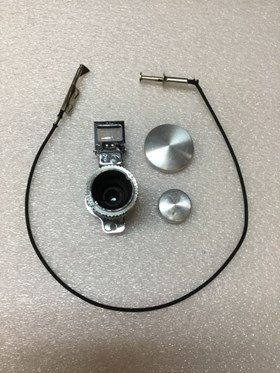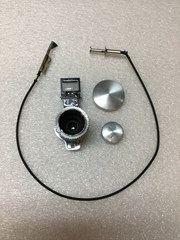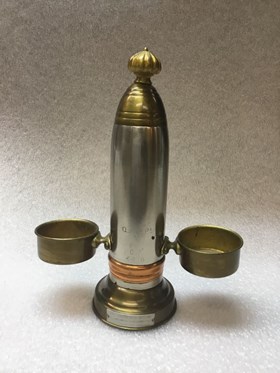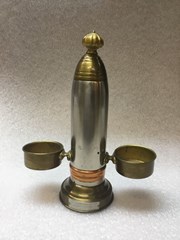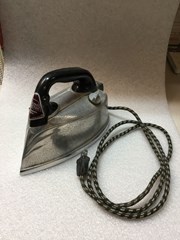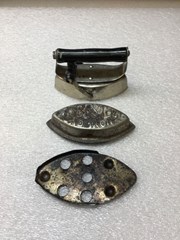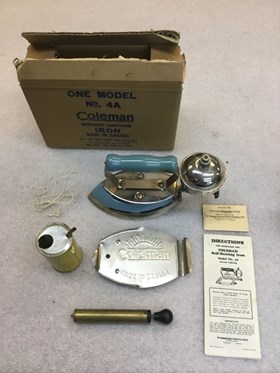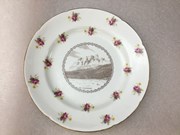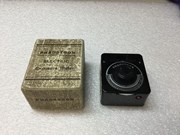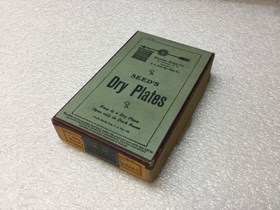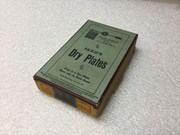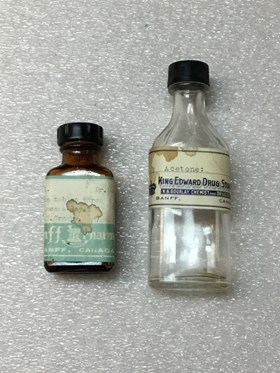Narrow Results By
Camera Accessories
https://archives.whyte.org/en/permalink/artifact104.41.0185%20a%2cb
- Date
- 1923 – 1940
- Material
- metal; glass; fabric;
- Catalogue Number
- 104.41.0185 a,b
- Description
- Silver metal Kodak lens with mounting plate that includes a fold-up view finder [possibly for a Ciné-Kodak motion picture camera] with black velvet-lined lens caps and a black fabric-wrapped extension trigger for an unknown camera.
1 image
- Title
- Camera Accessories
- Date
- 1923 – 1940
- Material
- metal; glass; fabric;
- Dimensions
- 4.2 x 4.1 x 9.6 cm
- Description
- Silver metal Kodak lens with mounting plate that includes a fold-up view finder [possibly for a Ciné-Kodak motion picture camera] with black velvet-lined lens caps and a black fabric-wrapped extension trigger for an unknown camera.
- Credit
- Gift of Robert Crosby Family, Banff, 1998
- Catalogue Number
- 104.41.0185 a,b
Images
This material is presented as originally created; it may contain outdated cultural descriptions and
potentially offensive content.
Read more.
- Date
- 1915 – 1916
- Material
- metal;
- Catalogue Number
- 102.05.0124
- Description
- Metal candle holder made from old artillery ammunition consisting of a central large silver bullet capped with a gold-coloured cap and decorative bauble on top and a copper band around the base, two gold-coloured candle holders on either side of an inscription on the bullet that reads “Q. F. 18PR V…
1 image
- Title
- Candle Holder
- Date
- 1915 – 1916
- Material
- metal;
- Dimensions
- 19.4 x 7.0 x 15.5 cm
- Description
- Metal candle holder made from old artillery ammunition consisting of a central large silver bullet capped with a gold-coloured cap and decorative bauble on top and a copper band around the base, two gold-coloured candle holders on either side of an inscription on the bullet that reads “Q. F. 18PR V F. C. F. 4-4-16,” and a wider gold-coloured base that has a small silver plaque that has the inscription “THE SHRAPNEL STAND COLONIAL FIXTURES LTD. REGISTERED 1915.”Souvenirs made from spent artillery shells were common during World War I. Objects such as boxes/cases, candle holders, simple toys, plates, cups, and more were prevalent due to the simple modifications to the ammunition that were needed.
- Credit
- Gift of Robert Crosby Family, Banff, 1998
- Catalogue Number
- 102.05.0124
Images
This material is presented as originally created; it may contain outdated cultural descriptions and
potentially offensive content.
Read more.
- Date
- 1950 – 1960
- Material
- metal; plastic; fabric;
- Catalogue Number
- 104.23.0013
- Description
- Silver metal electric clothes iron with a black plastic handle and a black and white fabric-wrapped power cord extending from the below the handle - a small metal cap twists off to the left of the handle so that water can be poured in. On the flat face of the iron is a small circular piece with sev…
1 image
- Title
- Clothes Iron
- Date
- 1950 – 1960
- Material
- metal; plastic; fabric;
- Dimensions
- 15.4 x 12.1 x 23.9 cm
- Description
- Silver metal electric clothes iron with a black plastic handle and a black and white fabric-wrapped power cord extending from the below the handle - a small metal cap twists off to the left of the handle so that water can be poured in. On the flat face of the iron is a small circular piece with several holes to allow the steam out at the top near the point - the rest of the face is smooth. On the front of the handle is a red metal badge with the manufacturer’s logo and at the back of the iron below the power cord is a black metal badge with the serial number.
- Subject
- Crosby family
- Abegweit
- clothing
- household items
- Credit
- Gift of Robert Crosby Family, Banff, 1998
- Catalogue Number
- 104.23.0013
Images
This material is presented as originally created; it may contain outdated cultural descriptions and
potentially offensive content.
Read more.
- Date
- 1890 – 1920
- Material
- metal; wood;
- Catalogue Number
- 104.23.0014
- Description
- Warning: This item contains asbestos - do not handle. Small metal clothes iron made up of three parts: a base plate with ventilation holes, a solid metal iron that would be heated, and a metal hood with a wooden handle and a spring-loaded lever that latches on to the solid iron. The iron has “ASBES…
1 image
- Title
- Clothes Iron
- Date
- 1890 – 1920
- Material
- metal; wood;
- Dimensions
- 6.2 x 4.4 x 9.7 cm
- Description
- Warning: This item contains asbestos - do not handle. Small metal clothes iron made up of three parts: a base plate with ventilation holes, a solid metal iron that would be heated, and a metal hood with a wooden handle and a spring-loaded lever that latches on to the solid iron. The iron has “ASBESTOS SAD IRON” molded throughout the top. Asbestos Sad Irons were produced from the late 1800s until electric steam irons gained popularity. The sold metal iron would be heated over a fire or stove and then picked up by placing the hood over it - the hood was lined with asbestos and also provided a small air pocket between the hot metal and the handle, making it slightly cooler and easier to handle.
- Credit
- Gift of Robert Crosby Family, Banff, 1998
- Catalogue Number
- 104.23.0014
Images
This material is presented as originally created; it may contain outdated cultural descriptions and
potentially offensive content.
Read more.
- Date
- 1930 – 1960
- Material
- cardboard; paper; metal;
- Catalogue Number
- 104.23.0015 a-d
- Description
- A blue and silver metal Coleman Self-Heating clothes iron with a stand plate, hand-held pump, instruction manual with spare parts, and Coleman Measuring Can in the original cardboard box. The iron consists of a solid metal base, blue body and handle, and a small fount on the back - it sits on a thi…
1 image
- Title
- Clothes Iron
- Date
- 1930 – 1960
- Material
- cardboard; paper; metal;
- Dimensions
- 19.2 x 11.6 x 29.3 cm
- Description
- A blue and silver metal Coleman Self-Heating clothes iron with a stand plate, hand-held pump, instruction manual with spare parts, and Coleman Measuring Can in the original cardboard box. The iron consists of a solid metal base, blue body and handle, and a small fount on the back - it sits on a thin metal stand that has the Coleman logo embossed on it and keeps the iron raised off of surfaces. The instruction manual details all aspects of using the iron and also has a small paper envelope with small spare parts inside. The Coleman Measuring Can is mostly yellow with an opening into which gasoline can be poured and a small curved spout on the top. Iron also has a small gold and black metal pump that, according to the instruction manual, is used to pump air into the fount. Everything except the measuring can is housed in the original cardboard box, kept closed with a piece of string.
- Subject
- Crosby family
- Abegweit
- household chores
- ironing
- Credit
- Gift of Robert Crosby Family, Banff, 1998
- Catalogue Number
- 104.23.0015 a-d
Images
This material is presented as originally created; it may contain outdated cultural descriptions and
potentially offensive content.
Read more.
Commemorative Plate
https://archives.whyte.org/en/permalink/artifact104.20.1283
- Date
- 1946 – 1979
- Material
- china;
- Catalogue Number
- 104.20.1283
- Description
- Decorative commemorative plate depicting an image of Mt. Eisenhower [Castle Mountain] with trees and the Bow River in the foreground in the depressed center of the plate - pink, purple, yellow, and green flower clusters decorate the rest of the plate and the edge of the plate is lined with gold.Cas…
1 image
- Title
- Commemorative Plate
- Date
- 1946 – 1979
- Material
- china;
- Dimensions
- 2.4 cm
- Description
- Decorative commemorative plate depicting an image of Mt. Eisenhower [Castle Mountain] with trees and the Bow River in the foreground in the depressed center of the plate - pink, purple, yellow, and green flower clusters decorate the rest of the plate and the edge of the plate is lined with gold.Castle Mountain [Miistukskoowa] was renamed Mt. Eisenhower in 1946 by Prime Minister Mackenzie King in honour of General Dwight D. Eisenhower’s involvement in World War II. Some local residents resented the name change and in 1979 it was reverted back to Castle Mountain, with the southeast end kept “Eisenhower Tower.”
- Subject
- Crosby family
- Abegweit
- decorations
- household items
- commemorative items
- Mt. Eisenhower
- Castle Mountain
- Credit
- Gift of Robert Crosby Family, Banff, 1998
- Catalogue Number
- 104.20.1283
Images
This material is presented as originally created; it may contain outdated cultural descriptions and
potentially offensive content.
Read more.
Commemorative Tin
https://archives.whyte.org/en/permalink/artifact110.01.0285
- Date
- 1935 – 1935
- Material
- metal; tin;
- Catalogue Number
- 110.01.0285
- Description
- Commemorative tin chocolate box celebrating the Silver Jubilee of King George V and Queen Mary. Box has a hinged lid with the Royal crest and portraits of the King and Queen printed on the lid and the manufacturer details on the bottom. The box is empty.
1 image
- Title
- Commemorative Tin
- Date
- 1935 – 1935
- Material
- metal; tin;
- Dimensions
- 1.7 x 6.5 x 19.3 cm
- Description
- Commemorative tin chocolate box celebrating the Silver Jubilee of King George V and Queen Mary. Box has a hinged lid with the Royal crest and portraits of the King and Queen printed on the lid and the manufacturer details on the bottom. The box is empty.
- Subject
- Crosby family
- Abegweit
- commemorative items
- British Royal Family
- King George VI and Queen Elizabeth
- Silver Jubilee
- chocolate box
- Credit
- Gift of Robert Crosby Family, Banff, 1998
- Catalogue Number
- 110.01.0285
Images
This material is presented as originally created; it may contain outdated cultural descriptions and
potentially offensive content.
Read more.
Exposure Meter
https://archives.whyte.org/en/permalink/artifact104.41.0195
- Date
- 1940 – 1941
- Material
- plastic; metal; cardboard;
- Catalogue Number
- 104.41.0195
- Description
- Black plastic hand-held exposure meter with a metal and plastic dial with a raised knob on the front below a depressed window where the exposure meter is. On the bottom of the meter just below the main dial is the exposed lip of the metal dial so that it can be rotated and a small round red plastic…
1 image
- Title
- Exposure Meter
- Date
- 1940 – 1941
- Material
- plastic; metal; cardboard;
- Dimensions
- 5.2 x 7.2 x 9.2 cm
- Description
- Black plastic hand-held exposure meter with a metal and plastic dial with a raised knob on the front below a depressed window where the exposure meter is. On the bottom of the meter just below the main dial is the exposed lip of the metal dial so that it can be rotated and a small round red plastic button. On the back of the meter is a metal screw in the middle [possibly to allow access to the interior], manufacturer details, and a thin strip of fabric adhesive with F.L. Crosby’s address details typed on it in black. The cardboard box has a patterned brown and white lid that fits completely over a beige body and is lined with packing cardboard.
- Credit
- Gift of Robert Crosby Family, Banff, 1998
- Catalogue Number
- 104.41.0195
Images
This material is presented as originally created; it may contain outdated cultural descriptions and
potentially offensive content.
Read more.
Exposure Plates
https://archives.whyte.org/en/permalink/artifact104.41.0207
- Date
- 1902 – 1920
- Material
- cardboard; paper; glass;
- Catalogue Number
- 104.41.0207
- Description
- Box of one dozen 3 1/4 x 5 1/2 glass Seed’s Dry Plates with cut paper adhesive tape around the edges and bottom and manufacturer details printed on a pale green background throughout the lid. These dry plates were invented by M.A. Seed in 1879 and became very popular with photographers as the plate…
1 image
- Title
- Exposure Plates
- Date
- 1902 – 1920
- Material
- cardboard; paper; glass;
- Dimensions
- 3.0 x 9.3 x 15.0 cm
- Description
- Box of one dozen 3 1/4 x 5 1/2 glass Seed’s Dry Plates with cut paper adhesive tape around the edges and bottom and manufacturer details printed on a pale green background throughout the lid. These dry plates were invented by M.A. Seed in 1879 and became very popular with photographers as the plates came pre-prepared with the emulsion layer already applied - prior to “dry” plates, photographers would need portable dark rooms in which they would create their liquid emulsions prior to taking a photograph [known as “wet” plates]. Seed’s dry plates still required they be opened in a dark room, but this could be accomplished in the field by placing a dark sheet over the camera while loading and unloading the plates. In 1902, Eastman Kodak purchased Seed’s company [Seed Dry Plate Co.], but continued to capitalize on his name due to its reputation among consumers.
- Credit
- Gift of Robert Crosby Family, Banff, 1998
- Catalogue Number
- 104.41.0207
Images
This material is presented as originally created; it may contain outdated cultural descriptions and
potentially offensive content.
Read more.
- Date
- 1920 – 1940
- Material
- glass; plastic; paper;
- Catalogue Number
- 110.01.0288 a,b
- Description
- Two glass drug store bottles with black plastic caps and paper adhesive labels on the front:a - tall and narrow clear glass bottle with a “KING EDWARD DRUG STORE” paper adhesive label on the front - “Acetone” is typed along the top of the label. Molded onto the back of the bottle are measurement ma…
1 image
- Title
- Glass Bottles
- Date
- 1920 – 1940
- Material
- glass; plastic; paper;
- Dimensions
- 12.1 x 2.6 x 4.1 cm
- Description
- Two glass drug store bottles with black plastic caps and paper adhesive labels on the front:a - tall and narrow clear glass bottle with a “KING EDWARD DRUG STORE” paper adhesive label on the front - “Acetone” is typed along the top of the label. Molded onto the back of the bottle are measurement markers.b - short and narrow brown glass bottle with a “Banff Pharmacy” paper adhesive label on the front - the label has typed instructions for taking tablet medication.
- Subject
- Crosby family
- Abegweit
- medicine
- drug store
- pharmacy
- Credit
- Gift of Robert Crosby Family, Banff, 1998
- Catalogue Number
- 110.01.0288 a,b
Images
This material is presented as originally created; it may contain outdated cultural descriptions and
potentially offensive content.
Read more.

